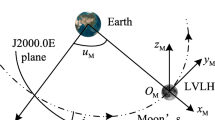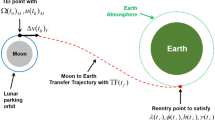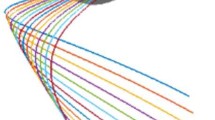Abstract
Point return orbit (PRO) of manned lunar mission is constrained by both lunar parking orbit and reentry corridor associated with reentry position. Besides, the fuel consumption and flight time should be economy. The patched conic equations which are adaptive to PRO are derived first, the PRO is modeled with fuel and time constraints based on the design variables of orbit parameters with clear physical meaning. After that, by combining analytical method with numerical method, a serial orbit design strategy from initial value design to precision solution is proposed. Simulation example indicates that the method has excellent convergence performance and precision. According to a great deal of simulation results by the method, the PRO characteristics such as Moon centered orbit parameters, Earth centered orbit parameters, transfer velocity change, etc. are analyzed, which can supply references to the manned lunar mission orbit scheme.
Similar content being viewed by others
References
Sommer S C, Short B J. Point Return From a Lunar Mission for a Vehicle that Maneuvers within the Earth’s Atmosphere. NASA TN D-1142, 1961
NASA. NASA’s Exploration Systems Achitecture Study. NASA-TM-2005-214062, 2005. 322–333
Penzo P A. An Analysis of Moon-To-Earth Trajectories. NASA-CR-132100, 1967
Graves C A, Harpold J C. Apollo Experience Report-Mission Planning for Apollo Entry. NASA TN D-6725, 1972
Frank III M P. Detailed Mission Planning Considerations and Constraints. NASA-TM-X-70045, 1966
Bai Y Z, Xi X N, Liu L, et al. Characteristic of Return Trajectory of Lunar Probe (in Chinese). J Nat Univ Def Tech, 2008, 30: 11–16
Gao Y D, Xi X N, Bai Y Z, et al. Fast Searching Design Method for Return Transfer Trajectory of Lunar Probe (in Chinese). Chin J Astron, 2008, 29: 765–771
Zhang L, Yu D Y, Zhang H. Preliminary Design and Characteristic Analysis of Moon-to-Earth Transfer Trajectories (in Chinese). Chin Space Sci Tech, 2011, 3: 62–70
Grigoriev K G, Grigoriev I S. Optimal Trajectories for the Return of a Spacecraft with Jet Engine of High Limited Thrust from the Moon to Earth. Cosm Res, 1995, 33: 513–532
Yan H, Gong Q, Park C D, et al. High-Accuracy Trajectory Optimization for a Trans-Earth Lunar Mission. J Guid, Contr, Dynam, 2011, 34: 1219–1217
Ocampo C, Hernandez S. A Method for Computing Optimal Multiple Finite Burn Moon to Earth Trajectories. AIAA/AAS Astrodynamics Specialist Conference, AIAA 2010-8133. Toronto, Ontario Canada: AIAA, 2010
Luo Y Z, Tang G J, Wang Z G, et al. Optimization of Perturbed and Constrained Fuel-Optimal Impulsive Rendezvous Using A Hybrid Approach. Eng Optim, 2006, 38: 959–973
Luo Y Z, Tang G J, Parks G. Multi-objective Optimization of Perturbed Impulsive Rendezvous Trajectories Using Physical Programming. J Guid, Contr, Dynam, 2008, 31: 1829–1832
Peng Q B, Shen H X, Li H Y. Free return orbit design and charateristics analysis for manned lunar mission. Sci China Tech Sci, 2012, 54: 3243–3250
Chen Y, Zhao G Q, Baoyin H X, et al. Orbit Design for Mars Exploration by the Accurate Dynamic Model (in Chinese). Chin Space Sci Tech, 2011, 1: 8–14
Shen H X, Li H Y, Peng Q B. Point Return Trajectory Characteristics Analysis for a Mooncraft (in Chinese). J Nat Univ Defen Tech, 2011, 33: 6–11
Huang W D, Xi X N, Wang W. Launch Window Analysis and Design for Manned Lunar Landing Return from the Moon (in Chinese). Chin J Spacecraft TT&C Tech, 2010, 29: 48–53
D’souza C, Crain T. Orion Cislunar Guidance and Navigation. AIAA 2007-6681, 2007
Bairstow S H. Reentry Guidance with Extended Range Capability for Low L/D Spacecraft. Dissertation of Masteral Degree. Cambridge: Massachusetts Institute of Technology, 2006
Vallado D A. Fundamentals of Astrodynamics and Applications. Torrance, CA: Microcosm Press, 2004
Gao Y D. Study on the Cislunar Transfer Trajectory of the Lunar Probe (in Chinese). Changsha: National University of Defense Technology, 2008
Vasile M, Ceriotti M, Radice G. Global Trajectotry Optimizaiton: Can we Prune the Solution Space when Considering Deep Space Manoeuvres. ESA Tech Report, 2008
Ugray Z, Leon L, John C, et al. Scatter Search and Local NLP Solvers: A Multistart Framework for Global Optimization. Inf J Comp, 2007, 19: 328–340
Cicolani L S. Orbits Returning from the Moon to a Specified Grographic Landing Area. NASA TN D-1652, 1963
Larson W J, Pranke L K. Human spaceflight: mission analysis and design. The McGraw-Hill Companies, Inc., 1998
Author information
Authors and Affiliations
Corresponding author
Rights and permissions
About this article
Cite this article
Shen, H., Zhou, J., Peng, Q. et al. Point return orbit design and characteristics analysis for manned lunar mission. Sci. China Technol. Sci. 55, 2561–2569 (2012). https://doi.org/10.1007/s11431-012-4969-4
Received:
Accepted:
Published:
Issue Date:
DOI: https://doi.org/10.1007/s11431-012-4969-4




